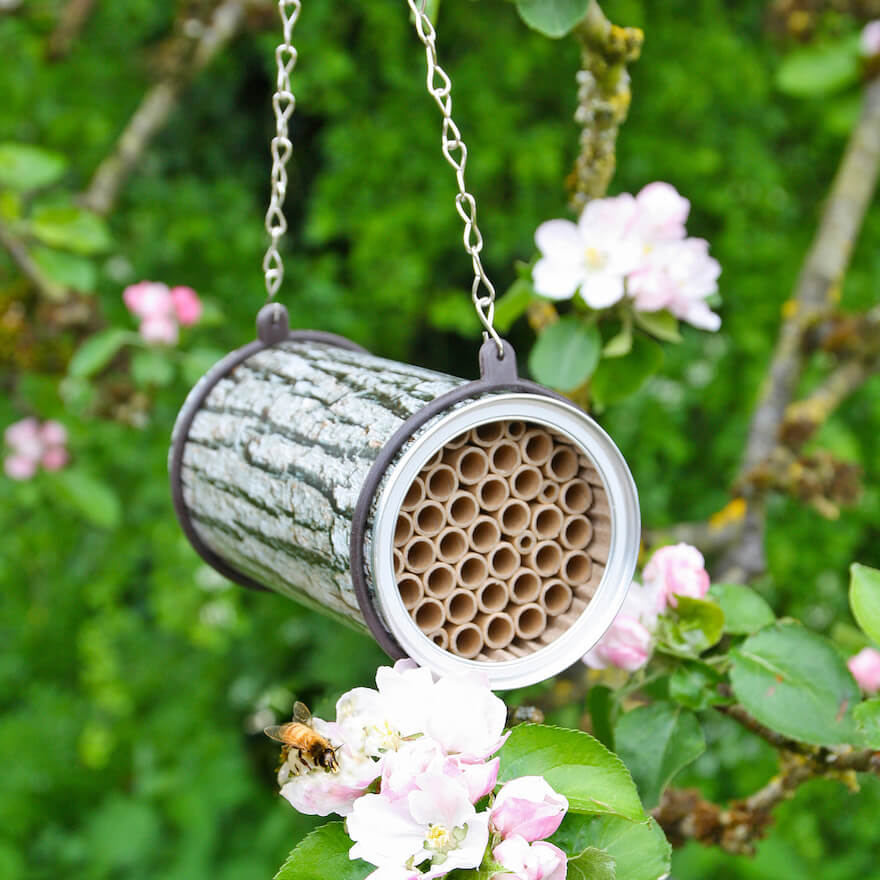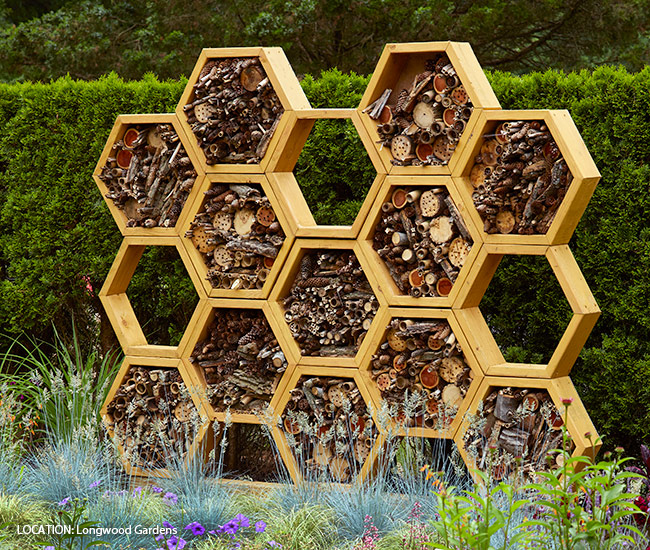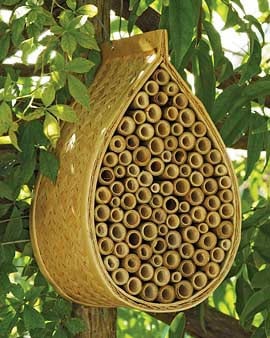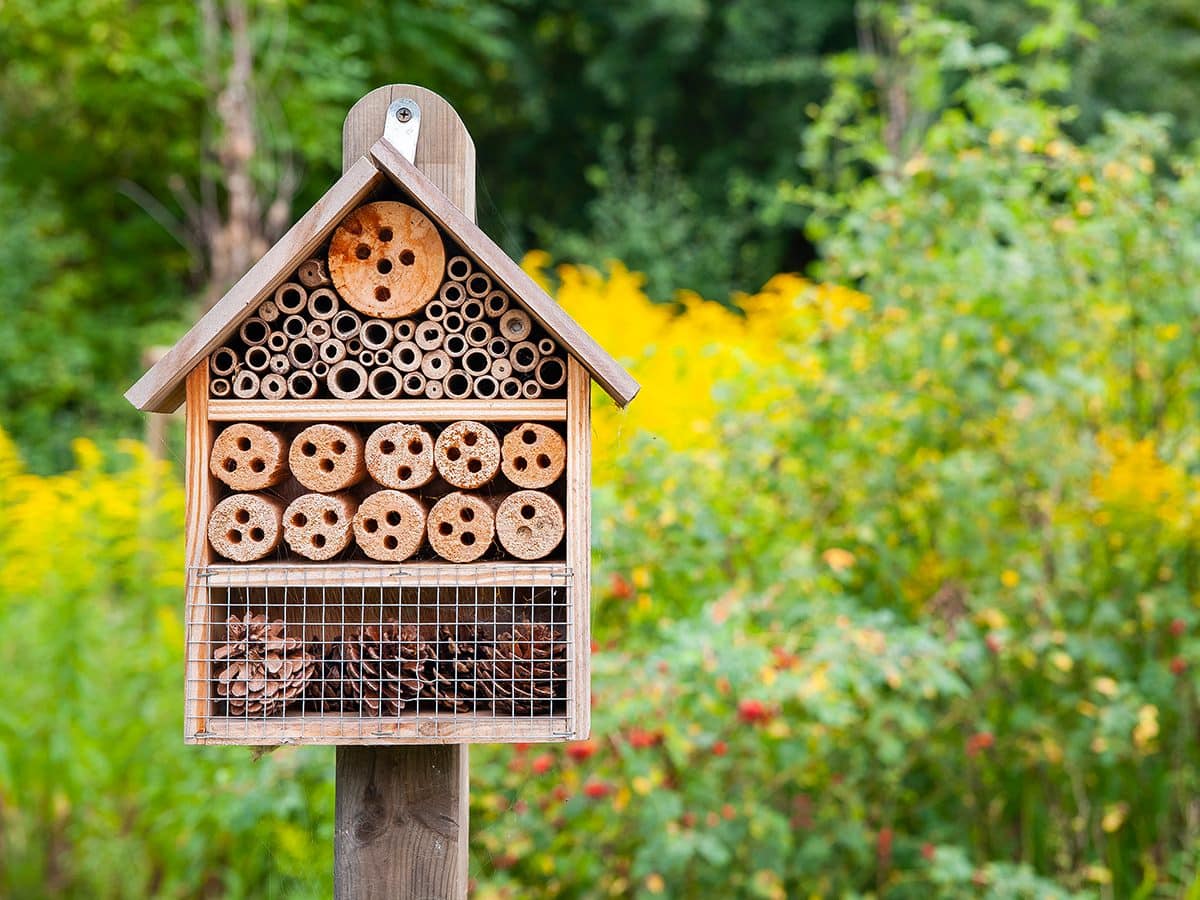Imagine sipping your morning coffee while watching busy bees flit around your garden, each one playing a crucial role in pollinating your plants. This simple pleasure can become a reality with the addition of bee houses to your outdoor space.
These charming structures not only enhance your garden’s aesthetics but also support the vital work of our buzzing friends. You might be wondering how a small wooden box can make such a difference. Well, bee houses provide a safe haven for solitary bees, crucial pollinators who often go unnoticed.
By placing one in your garden, you’re not just decorating; you’re contributing to a healthier ecosystem. Curious to learn how you can transform your garden into a sanctuary for these essential creatures? Keep reading to discover how bee houses can make a buzzing difference.

Credit: www.thebirdhousechick.com
JUMP TO TOPIC
Benefits Of Bee Houses
Bee houses have become popular among garden enthusiasts. They offer numerous benefits. These small structures attract solitary bees. Solitary bees are vital pollinators. They boost garden productivity. Bee houses also support biodiversity and improve garden health.
Enhanced Pollination
Bee houses attract solitary bees. These bees are excellent pollinators. They visit more flowers than honeybees. This increases pollination efficiency. Enhanced pollination leads to better fruit and vegetable yields. Your garden becomes more productive.
Biodiversity Support
Bee houses promote biodiversity. They provide a safe habitat for solitary bees. Solitary bees include mason and leafcutter bees. These bees face threats from habitat loss. Bee houses offer them a refuge. A diverse bee population helps balance the ecosystem. It supports other insects and wildlife.
Garden Health Improvement
Bee houses contribute to garden health. They attract bees that control pest populations. Some solitary bees prey on harmful insects. This reduces the need for chemical pesticides. Natural pest control keeps plants healthy. It also preserves soil quality.
Types Of Bee Houses
Garden bee houses come in various types. The popular ones include wooden boxes, bamboo tubes, and ceramic pots. Each design attracts different bee species, enhancing pollination and biodiversity in your garden.
When you think about adding a bee house to your garden, the variety of options might surprise you. Bee houses are not just a home for these buzzing pollinators; they are a way to enhance your garden’s health. Different materials offer unique benefits and appeal to various types of bees. Let’s explore some popular types to help you decide which is the best fit for your garden sanctuary.Wooden Bee Houses
Wooden bee houses are a classic choice. They blend naturally with garden settings and provide excellent insulation. Their simple design makes them easy to clean and maintain. Many gardeners, including myself, have found success with wooden bee houses. They attract solitary bees like mason bees, which are great for pollination. Consider placing your wooden bee house in a sunny spot, as bees are attracted to warmth.Clay Bee Houses
Clay bee houses are another appealing option. They offer a sturdy, long-lasting home for bees. The porous nature of clay helps regulate temperature and moisture, creating a comfortable environment. In my experience, clay bee houses attract leafcutter bees, which are effective pollinators. Positioning them near flowering plants can maximize pollination. Have you tried clay bee houses in your garden?Mixed Material Bee Houses
Mixed material bee houses combine wood, clay, and sometimes bamboo. They provide versatility and can cater to a wider variety of bee species. The combination of materials can offer the best of both worlds: insulation from wood and moisture control from clay. These bee houses can be both functional and decorative. They add a unique aesthetic to your garden while supporting biodiversity. If you’re looking for a bee house that stands out, this might be the option for you. Choosing the right bee house can be an enriching experience for both you and your garden. Consider what fits best with your garden’s needs and aesthetic. Which type of bee house will you choose to support your buzzing friends?Choosing The Right Location
Choosing the right location for your bee house is crucial. It determines how effective the bee house will be in attracting and nurturing bees. With careful planning, you can create an inviting habitat that supports your garden’s pollination needs.
Sunlight Exposure
Bees love sunlight. Position your bee house where it will receive morning sun. This warms the bees and encourages them to start their day early, benefiting your garden. Avoid areas that are shaded for most of the day. A sunny spot will make your bee house a buzzing hub of activity.
Protection From Wind
Wind can be a challenge for bees. Find a location that offers some shelter from strong winds. Place the bee house near a fence or hedge for added protection. This helps keep the bee house stable, ensuring the bees can come and go without struggle.
Proximity To Flowers
Bees need flowers to thrive. Position your bee house close to a variety of flowers. This makes it easier for bees to find pollen and nectar. Consider planting native flowers that bloom at different times to provide a continuous food source. How close is your nearest flower bed?
Building Your Own Bee House
Create a cozy bee house in your garden to welcome these vital pollinators. Use natural materials like wood or bamboo. Bees help flowers bloom and plants grow, making your garden thrive.
Building your own bee house can enhance your garden’s biodiversity. It’s a rewarding project that supports local bee populations. Bees are crucial pollinators, and providing them a habitat helps your garden thrive. This guide will walk you through the process of creating a bee-friendly home.Materials Needed
Gathering the right materials ensures a sturdy bee house. You’ll need untreated wood, bamboo canes, or hollow reeds. These materials mimic natural bee habitats. Also, get a saw, drill, and sandpaper. Ensure you have nails or wood glue for assembly. Optional items include waterproof paint for decoration.Step-by-step Guide
Start by cutting your wood into a rectangular frame. Use the saw for precise cuts. Drill holes in the wood, about 6 inches deep. Make sure the holes are smooth. Insert bamboo canes or reeds into the drilled holes. Secure them with nails or wood glue. Sand any rough edges to prevent bee injury. Optionally, paint the exterior with waterproof paint.Safety Tips
Safety is key when building your bee house. Wear gloves to protect your hands while cutting and drilling. Use safety goggles to shield your eyes from wood shavings. Keep tools away from children and pets. If using paint, ensure it’s non-toxic to avoid harming bees. Always work in a well-ventilated area for safety.Maintaining Bee Houses
Bee houses are a delightful addition to any garden. They support pollinators and enhance biodiversity. Proper maintenance ensures these houses stay inviting for bees. It also keeps your garden buzzing with life. Regular care helps bees thrive and continue their important work.
Cleaning And Upkeep
Clean bee houses each season for optimal health. Remove debris and old nesting materials. This prevents disease and keeps bees safe. Use gentle methods to avoid damaging the house. Be mindful of any bees that might still be inside.
Monitoring Bee Activity
Observe bee activity regularly. Check for signs of disease or pests. Healthy bees are active and vibrant. If activity decreases, investigate further. Ensure the environment remains favorable for the bees.
Seasonal Adjustments
Adjust bee houses according to the season. In winter, provide insulation for warmth. During rainy seasons, ensure proper drainage. Keep bee houses sheltered from extreme weather. This keeps the bees comfortable all year round.

Credit: www.gardengatemagazine.com
Attracting Bees To Your Garden
Bee houses invite these important pollinators to your garden. They offer bees a safe place to rest and nest. Placing bee houses near flowers boosts pollination and enriches garden health.
Attracting bees to your garden is more than just about boosting plant pollination; it’s about fostering a thriving ecosystem. Bees are vital for the health of many plants, including fruits and vegetables you may grow. By creating a bee-friendly environment, you not only help these crucial creatures but also enhance your garden’s productivity and beauty.Planting Bee-friendly Flowers
Choose a variety of flowers that bloom at different times of the year. This ensures that bees have a constant source of nectar and pollen. Consider adding plants like lavender, sunflowers, and coneflowers, which are known favorites among bees. Native plants are particularly effective in attracting local bee species. They are adapted to your region’s climate and soil conditions, making them easier to maintain. Plus, native plants often have the perfect structure for the bees that naturally occur in your area.Providing Water Sources
Bees need water for hydration and to cool their hives. Add a shallow dish filled with water and some stones for the bees to land on. This simple addition can make a big difference in attracting bees to your garden. A small birdbath with a gentle slope can also serve as a great water source. Make sure to keep it clean and filled, especially during hot weather. You’ll likely notice more bees visiting your garden once they know there’s a reliable water source.Avoiding Pesticides
Pesticides can be harmful to bees, often leading to their decline. Consider natural pest control methods, such as introducing beneficial insects like ladybugs to manage pests. These alternatives can help maintain a healthy garden without deterring bees. If you must use pesticides, opt for organic ones and apply them during times when bees are less active, such as early morning or late evening. It’s crucial to read labels carefully to ensure they’re bee-safe. Your garden will thrive with the right balance of pest control and pollination. Have you ever noticed that a pesticide-free garden seems to buzz with more life? It’s not just your imagination. Avoiding harsh chemicals can significantly boost bee populations in your garden.Community And Environmental Impact
Bee houses are not just charming garden additions. They have significant community and environmental benefits. These small structures support local ecosystems and promote conservation. They also provide educational opportunities for all ages. Their impact reaches far beyond a single garden.
Educational Opportunities
Bee houses offer unique learning experiences. They teach about pollinators and their vital roles. Observing bees up close can spark curiosity. Schools and community groups can use bee houses for lessons. They provide a hands-on way to learn about nature.
Supporting Local Ecosystems
Bee houses help maintain local biodiversity. They provide homes for solitary bees, which are crucial pollinators. These bees help plants grow and produce fruit. A healthy bee population benefits the entire ecosystem. Gardens thrive with these buzzing helpers.
Contributing To Conservation Efforts
Bee houses aid in conservation. They support declining bee populations. By providing a safe habitat, they help bees survive. This small step can make a big difference. Bee houses contribute to broader conservation goals. They encourage community involvement in environmental efforts.

Credit: www.gardeners.com
Frequently Asked Questions
Should You Put A Bee House In Your Garden?
Yes, placing a bee house in your garden supports pollination and biodiversity. It provides a safe habitat for solitary bees. Ensure it’s positioned in a sunny spot, sheltered from rain. Regular maintenance prevents pests. A bee house enhances your garden’s ecosystem naturally and sustainably.
Are Bee Houses Worth It?
Bee houses are worth it for attracting solitary bees, boosting pollination, and supporting local ecosystems. They provide a safe habitat, enhancing garden health and productivity. Proper placement and maintenance are crucial for effectiveness. Investing in a bee house contributes to biodiversity and promotes a sustainable environment.
Will A Mason Bee House Attract Wasps?
A mason bee house can sometimes attract wasps. Wasps may use the tubes or holes for nesting. To minimize this, regularly clean and maintain the bee house. Choose a location away from common wasp areas, such as trash bins or compost piles.
What Is The 3 Feet 3 Mile Rule For Bees?
The 3 feet 3 mile rule helps in relocating beehives. Move them either less than 3 feet or over 3 miles. Bees adapt better to these distances, ensuring they find their way back. This minimizes confusion and stress for the bees, maintaining hive efficiency.
Conclusion
Bee houses offer a sanctuary for garden pollinators. They attract helpful bees, boosting plant growth. Installing one supports biodiversity. It’s a simple way to help nature thrive. Plus, these houses add charm to any garden. Watching bees work is educational and fun.
You don’t need much space to start. Just find a sunny spot and set it up. Soon, you’ll see bees buzzing happily. It’s a rewarding experience for all garden lovers. Enjoy the beauty and benefits they bring. Dive into this eco-friendly venture today.
Your garden, and the planet, will thank you.

